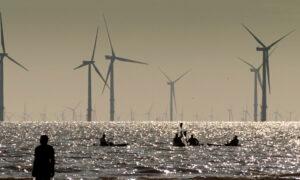The world’s largest offshore wind developer is discontinuing work on a giant UK project in its current form because of rising costs and the risk of delays.
While the UK’s Climate Change Act 2008 embeds legally binding carbon targets into law and creates favourable conditions for the wind industry, Orsted still faces challenges.
“The adverse macroeconomic developments, continued supply chain challenges, and increased execution, market and operational risks have eroded the value creation,” Orsted CEO Rasmus Errboe said in a statement.
He also said that the company would “seek to develop the project later in a way that is more value-creating for us and our shareholders.”
Orsted develops, constructs, and operates offshore and onshore wind farms, solar farms, energy storage facilities, renewable hydrogen and green fuels facilities, and bioenergy plants.
It operates 12 offshore wind farms in the UK, including Hornsea 1, which held the title of the world’s largest wind farm until its sister project, Hornsea 2, came into operation with 165 turbines in August 2022.
The department stated that it was exploring changing rules for the next big AR7 auction for subsidized wind power sites so that projects can get their contracts confirmed sooner.
A spokeswoman for the DESNZ told The Epoch Times via email: “We recognise the effect that globally high inflation and supply chain constraints are having on industry across Europe, and we will work with Orsted to get Hornsea 4 back on track.
“We have a strong pipeline of projects to deliver clean power by 2030 and our mission-led approach ensures we can steer our way through global pressures and individual commercial decisions to reach our targets.”
A source familiar with the matter told The Epoch Times that the government is working to get Hornsea 4 back on track and for the project to happen by 2030.
‘Buyer’s Remorse’
Gordon Hughes, a former professor of economics at the University of Edinburgh and former senior adviser on energy and environmental policy at the World Bank, previously told The Epoch Times via email that “it is all a massive case of buyer’s remorse because of excessive optimism about future costs five years ago.”In the past two years, industry giants such as Orsted, Siemens Energy, and Vestas have been forced to reassess their investment strategies as financial setbacks pile up.
Shifting investor sentiment and U.S. President Donald Trump’s renewed push for oil and gas have also added to the wind industry’s challenges. The president suspended offshore wind leases on his first day in office.
Trump’s action is a shift from the previous administration’s four-year effort to expand wind-power leasing, which aimed to build 30 GW of offshore wind power by 2030 and another 15 GW of floating offshore wind power by 2035.







